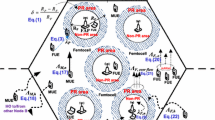Abstract
A heterogeneous network (HetNet) is one of the core features that have been introduced in the LTE-advanced standardization to meet the predicted requirements for higher data rates and capacity. An integrated picocellular–macrocellular networks is part of such HetNets. Most previous works have concentrated on solving the picocellular–macrocellular networks challenges, including optimal picocell deployment, interference coordination, cell association methods and frequency resource allocations. However, the resource allocation control issue for LTE macrocells integrated with underlying picocells owned by different operators that can allow macrocell user (MU) accommodation has not been investigated deeply. Therefore, this paper proposes and analyzes a new resource allocation control framework called a preemption-based call admission control scheme (PCAC) for integrating independent underlying picocells with macrocell networks. The proposed scheme aims to utilize the resource blocks (RBs) of picocells efficiently to improve MU performance by allowing its MU visitors to utilize unused picocell RBs without any degradation for picocell users. A developed simulation model and a multi-dimensional continuous-time Markov chain (CTMC) model are used to model and analyze the proposed PCAC. The analytical model developed considers a limited-size buffer to store MUs, buffer time out and resource reservation. The MU connection-level performance metrics, including dropping and blocking probabilities, are derived and studied. The results indicate that better connection-level parameters for MUs and higher throughputs are achieved by using the proposed PCAC.
Similar content being viewed by others
References
Landström, S.; Furuskär, A.; Johansson, K.; Falconetti, L.; Kronestedt, F.: Heterogeneous networks (HetNets)—an approach to increasing cellular capacity and coverage. Ericsson Review, No 1, February 11 (2011)
3GPP, Evolved Universal Terrestrial Radio Access (E-UTRA); Physical layer; Measurements (Release 10). TS 36.214 v10.1.0, March (2011)
Blankenship, Y.W.: Achieving High Capacity with Small Cells in LTE-A. Fiftieth Annual Allerton Conference, pp 1680–1687, October (2012)
Damnjanovic A., Montojo J., Yongbin W., Tingfang J., Tao L., Vajapeyam M., Taesang Y., Osok S., Malladi D.: A survey on 3GPP heterogeneous networks. IEEE Wirel. Commun. 18(3), 10–21 (2011)
Eguizabal, M.; Hernandez, A.: Interference management and cell range expansion analysis for LTE picocell deployments. In: 24th IEEE International Symposium on Personal Indoor and Mobile Radio Communications (PIMRC), pp. 1592–1597 (2013)
Strzyz, S.; Pedersen, K.I.; Lachowski, J.; Frederiksen, F.: Performance optimization of pico node deployment in LTE macro cells. In: Proceedings of Future Network & Mobile Summit, pp. 1–9, June (2011)
Brueck, S.: Heterogeneous networks in LTE-advanced. In: IEEE ISWCS, pp. 171–175, November (2011)
Landstrom, S.; Murai, H.; Simonsson, A.: Deployment Aspects of LTE Pico Nodes. IEEE International Conference on Communications Workshops (ICC), pp. 1–5, June (2011)
Daeinabi, A.; Sandrasegaran, K.; Zhu, X.: Performance evaluation of cell selection techniques for picocells in LTE-advanced networks. In: 10th International Conference on Electrical Engineering/Electronics, Computer, Telecommunications and Information Technology (ECTI-CON) (2013)
Shrestha, B.; Hossain, E.; Choi, K.W.: An Analysis of Wireless Backhaul for Picocell Base Stations in Heterogeneous Networks. IEEE Globecom Workshops (GC Wkshps) (2013)
Yu, Y.; Gu, D.: The cost efficient location management in the LTE picocell/macrocell Network. IEEE Commun. Lett. 175, 904–907, 171–175 (2013)
Obaid, N.; Czylwik, A.: An efficient macrocell power control algorithm for enhancing dense picocell deployments. In: Proceedings of 20th European Wireless Conference; pp. 1–6, May (2014)
Kumar, S.; Kalyani, S.; Giridhar, K.: Spectrum allocation for ICIC based picocell. In: IEEE Transactions On Vehicular Technology (2014)
Mimura T., Yamamoto K., Morikura M., Iwata A., Tamura T.: Fixed-rate resource exchange for multi-operator pico eNodeB. IEICE Trans. Commun. 2013(11), 2913–2922 (2013)
Ross S.: Introduction to Probability Models, 10th edn. Elsevier, New York (2011)
Law A., Kelton W.: Simulation Modeling and Analysis, 3rd edn. McGraw-Hill, New York (2000)
Author information
Authors and Affiliations
Corresponding author
Rights and permissions
About this article
Cite this article
Alqahtani, S.A. Performance Analysis of Preemption-Based Call Admission Scheme for Macrocell Users in Multi-Operator LTE Picocellular–Macrocellular Networks. Arab J Sci Eng 40, 2487–2501 (2015). https://doi.org/10.1007/s13369-015-1662-5
Received:
Accepted:
Published:
Issue Date:
DOI: https://doi.org/10.1007/s13369-015-1662-5




